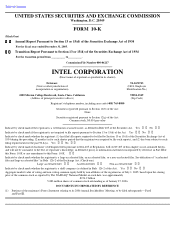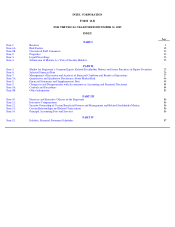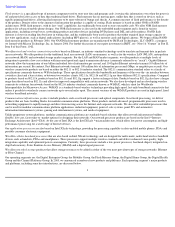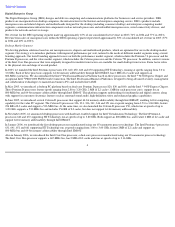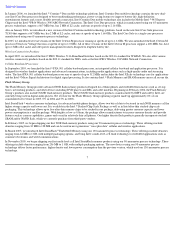Intel 2005 Annual Report Download - page 13
Download and view the complete annual report
Please find page 13 of the 2005 Intel annual report below. You can navigate through the pages in the report by either clicking on the pages listed below, or by using the keyword search tool below to find specific information within the annual report.
Table of Contents
As of year-end 2005, the majority of our microprocessors were manufactured on 300mm wafers using our 90-nanometer process technology. In 2005,
we began manufacturing microprocessors on our 65-nanometer process technology, the next generation beyond our 90-nanometer process technology.
As we move to each succeeding generation of manufacturing process technology, we incur significant start-up costs to get each factory ready for high-
volume manufacturing. However, continuing to advance our process technology provides added benefits that we believe justify these costs. These
benefits can include utilizing less space per transistor, which enables us to put more transistors on an equivalent size chip, decreasing the size of the
chip or allowing us to offer an increased number of integrated features. These advancements can result in higher performing microprocessors, products
that consume less power and/or products that cost less to manufacture. To augment capacity in the U.S. and internationally, we use third-party
manufacturing companies (foundries) to manufacture wafers for certain components, including networking and communications products.
In January 2006, we formed IMFT, a NAND flash memory manufacturing company, with Micron. IMFT manufactures for Intel and Micron, and we
currently purchase 49% of the manufactured output. See “Note 16: Venture” in Part II, Item 8 of this Form 10-K.
We primarily use subcontractors to manufacture board-level products and systems, and purchase certain communications networking products from
external vendors, primarily in the Asia-Pacific region. We also manufacture microprocessor- and networking-related board-
level products, primarily in
Malaysia.
Following manufacture, the majority of our components are subject to assembly in several types of packaging, and to testing. We perform a substantial
majority of our components assembly and test at facilities in Malaysia, China, the Philippines and Costa Rica. We plan to continue to invest in new
assembly and test technologies and facilities to keep pace with our microprocessor, chipset, flash memory and communications technology
improvements. To augment capacity, we use subcontractors to perform assembly of certain products, primarily flash memory, chipsets, and
networking and communications products. Assembly and test of NAND flash memory products manufactured by IMFT in 2006 is performed by
Micron.
Our performance expectations for business integrity; ethics; and environmental, health and safety compliance are the same regardless of whether our
supplier and subcontractor operations are based in the U.S. or elsewhere. Our employment practices are consistent with, and we expect our suppliers
and subcontractors to abide by, local country law. In addition, we impose a minimum employee age requirement regardless of local law.
We have thousands of suppliers, including subcontractors, providing our various materials and service needs. We set expectations for supplier
performance and reinforce those expectations with periodic assessments. We communicate those expectations to our suppliers regularly and work with
them to implement improvements when necessary. We seek, where possible, to have several sources of supply for all of these materials and resources,
but we may rely on a single or limited number of suppliers, or upon suppliers in a single country. In those cases, we develop and implement plans and
actions to reduce the exposure that would result from a disruption in supply.
Our products typically are produced at multiple Intel facilities at various sites around the world, or by subcontractors who have multiple facilities.
However, some products are produced in only one Intel or subcontractor facility, and we seek to implement actions and plans to reduce the exposure
that would result from a disruption at any such facility. On a worldwide basis, we regularly review our key infrastructure, systems, services and
suppliers, both internally and externally, to seek to identify significant vulnerabilities as well as areas of potential business impact if a disruptive event
were to occur. Once a vulnerability is identified, we assess the risks, and as we consider it to be appropriate, we initiate actions intended to reduce the
risks and their potential impact. However, there can be no assurance that we have identified all significant risks or that we can mitigate all identified
risks with reasonable effort. See “Risk Factors” in Part I, Item 1A of this Form 10-K.
We maintain a program of insurance coverage for various types of property, casualty and other risks. We place our insurance coverage with various
carriers in numerous jurisdictions. The policies are subject to deductibles and exclusions that result in our retention of a level of risk on a self-
insurance basis. The types and amounts of insurance obtained vary from time to time and from location to location depending on availability, cost and
our decisions with respect to risk retention. Our worldwide risk and insurance programs are regularly evaluated to seek to obtain the most favorable
terms and conditions.
Research and Development
We continue to be committed to investing in world-class technology development, particularly in the area of the design and manufacture of integrated
circuits. Research and development (R&D) expenditures in 2005 amounted to $5.1 billion ($4.8 billion in fiscal 2004 and $4.4 billion in fiscal 2003).
Additionally, we increased the number of our employees engaged in R&D to approximately 29,000 as of December 2005 compared to approximately
25,000 as of December 2004.
9


